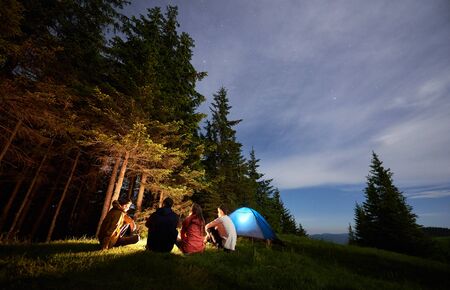Introduction to Sustainable Camping
Camping is one of the best ways to connect with nature, but it also comes with a responsibility to protect the environment we enjoy. As outdoor enthusiasts, its important to think about how our gear choices and camping habits impact the planet. Thats where sustainable camping comes in — a growing movement focused on eco-friendly practices and gear that help reduce our environmental footprint.
Why Sustainable Camping Matters
Every year, millions of people head outdoors for hiking, backpacking, and camping adventures. Unfortunately, this can lead to issues like pollution, littering, and damage to natural habitats. By choosing sustainable camping gear and practicing Leave No Trace principles, campers can help preserve these beautiful spaces for future generations.
The Role of Gear in Eco-Friendly Camping
Sustainable camping gear is designed to be durable, reusable, and made from environmentally responsible materials. It not only helps reduce waste but also lowers the demand for new resources. Whether you’re camping in summer or winter, selecting the right gear plays a big part in minimizing your impact on the environment.
Key Features of Sustainable Camping Gear
| Feature | Description |
|---|---|
| Recycled Materials | Products made from reused plastics, fabrics, or metals reduce landfill waste and energy consumption. |
| Durability | High-quality gear lasts longer, meaning less frequent replacement and reduced resource use. |
| Repairable Design | Items designed for easy repairs help extend their lifespan and prevent unnecessary disposal. |
| Eco-Friendly Packaging | Minimal or biodegradable packaging cuts down on trash left behind after purchase. |
| Non-Toxic Materials | Avoiding harmful chemicals protects both nature and your health during outdoor use. |
Good for Nature, Great for You
Sustainable gear doesn’t just benefit the planet — it often performs better too. Many eco-conscious brands focus on quality craftsmanship and innovation, giving you products that are lightweight, weather-resistant, and built to last across all four seasons. Making these smart choices helps ensure your next adventure leaves nothing but footprints behind.
2. Essential Eco-Friendly Gear for All Seasons
When it comes to camping sustainably, choosing the right gear is key—not just for minimizing your environmental impact, but also for ensuring comfort and convenience no matter the season. Whether youre braving the chill of winter or enjoying a sunny summer hike, eco-friendly gear can make a big difference in your outdoor experience. Below are some top picks that combine sustainability with all-season functionality.
Biodegradable Cookware and Utensils
Say goodbye to single-use plastics and hello to biodegradable cookware made from materials like bamboo, cornstarch, or recycled stainless steel. These items are durable enough for year-round use and break down naturally when disposed of properly.
Popular Options:
| Item | Material | Best For |
|---|---|---|
| Bamboo Cutlery Set | Bamboo | All seasons, lightweight trips |
| Compostable Plates | Sugarcane or cornstarch fiber | Group camping meals |
| Recycled Steel Pot | Recycled stainless steel | Year-round cooking over fire or stove |
Solar-Powered Lanterns and Chargers
Solar-powered gear is a game changer for eco-conscious campers. From lanterns that light up your tent at night to portable solar panels that keep your devices charged, these tools reduce reliance on disposable batteries and fossil fuels.
Top Picks:
- Solar Lanterns: Collapsible models are perfect for packing and provide hours of light after just a few hours of sun exposure.
- Solar Power Banks: Ideal for charging phones, GPS units, or headlamps during multi-day adventures.
- Multi-Use Solar Panels: Mount them on your backpack during hikes to collect energy while you walk.
All-Weather Reusable Water Bottles & Filtration Systems
Staying hydrated is essential in every season, and using reusable bottles cuts down on plastic waste. Combine them with portable filtration systems to stay safe while drinking from streams, lakes, or rivers.
Recommended Gear:
| Product | Description | Sustainability Feature |
|---|---|---|
| Insulated Stainless Steel Bottle | Keeps liquids hot or cold for hours | Reusable, BPA-free, long-lasting material |
| Pocket Water Filter Pump | Cleans water from natural sources on the go | No need for bottled water or chemicals |
| Squeeze Filter System | Lightweight and easy to use during hikes | No disposable filter cartridges needed |
Sustainable Clothing Layers
Dressing smart is part of being prepared for any season. Choose layers made from recycled fabrics, organic cotton, or responsibly sourced wool to stay warm (or cool) without harming the planet.
- Base Layers: Look for moisture-wicking shirts made from recycled polyester or merino wool.
- Insulating Layers: Fleece made from post-consumer plastics offers warmth without bulk.
- Outerwear: Jackets with eco-friendly DWR (durable water repellent) finishes keep you dry in wet conditions.
The right sustainable gear lets you camp comfortably through spring blooms, summer heatwaves, autumn breezes, and snowy winters—all while keeping nature as pristine as you found it.

3. Seasonal Sustainability Tips
Every season brings unique challenges and opportunities for sustainable camping. Whether youre braving the cold in winter or enjoying the sunshine in summer, making eco-conscious choices can help preserve nature while keeping your gear efficient and long-lasting. Heres how to adapt your camping habits and gear for each season without compromising on sustainability.
Winter: Stay Warm, Stay Green
Cold weather calls for extra insulation and smart packing. Look for gear made from recycled materials like sleeping bags with recycled down or synthetic fill. Instead of single-use heat packs, opt for rechargeable hand warmers. Choose a four-season tent thats durable and built to last through many winters.
Winter Tips:
- Use solar-powered lanterns with extended battery life.
- Layer clothing with eco-friendly wool or recycled fleece.
- Melt snow for water using a stove that runs on renewable fuel sources.
Spring: Embrace the Wet Season Responsibly
Spring often means rain and mud, so waterproof yet eco-friendly gear is essential. Choose rain jackets and tarps made from PFC-free materials. Spring is also a great time to practice Leave No Trace principles as new growth appears in the wilderness.
Spring Tips:
- Stick to established trails to avoid damaging emerging plants.
- Pack biodegradable soap and reusable cleaning cloths.
- Set up camp away from rivers and streams to prevent erosion.
Summer: Go Light, Go Solar
The summer sun is perfect for harnessing solar power. Use solar chargers for your devices and LED lights. Lightweight, breathable gear reduces your impact both physically and environmentally. Avoid disposable plastics by packing reusable utensils and containers.
Summer Tips:
- Bring a solar shower bag instead of single-use wipes.
- Use reef-safe sunscreen when swimming in lakes or rivers.
- Stay cool with bamboo or hemp-based clothing—both are sustainable fabrics.
Fall: Gear Up for Changing Conditions
Autumn weather can be unpredictable, so versatile gear is key. Look for multi-layer systems that you can adjust as temperatures shift. Repair your existing equipment using repair kits instead of buying new items each season. Its also a great time to evaluate your gears lifecycle before winter hits again.
Fall Tips:
- Use a compostable trash bag to pack out waste during leaf-heavy hikes.
- Choose tents and backpacks made with bluesign®-approved materials.
- Dry out gear thoroughly before storing it to extend its lifespan.
Sustainable Gear Checklist by Season
| Season | Sustainable Gear Must-Haves |
|---|---|
| Winter | Recycled down sleeping bag, rechargeable hand warmers, four-season tent |
| Spring | PFC-free rain jacket, biodegradable soap, reusable food containers |
| Summer | Solar charger, bamboo clothing, refillable water bottle with filter |
| Fall | Layered clothing system, repair kit, compostable trash bags |
No matter what time of year you head out into nature, small changes in your camping habits can make a big difference. By choosing sustainable gear and adapting your routines seasonally, youre helping protect the very places you love to explore.
4. Top Brands Leading the Green Gear Movement
When it comes to sustainable camping gear, some outdoor brands are going above and beyond to protect the planet while keeping adventurers well-equipped year-round. These companies are based both in the U.S. and around the world, and they focus on eco-conscious practices like ethical sourcing, responsible manufacturing, and using recyclable or biodegradable materials.
What Makes a Brand Sustainable?
Before diving into our top picks, heres what we looked for in a green gear brand:
- Ethical Sourcing: Materials are sourced responsibly from suppliers who treat workers fairly and minimize environmental impact.
- Eco-Friendly Materials: Products are made using recycled fabrics, organic cotton, plant-based dyes, or biodegradable components.
- Sustainable Manufacturing: Factories use renewable energy, reduce waste, or offset carbon emissions.
- Recyclability: Gear is designed to be reused, repaired, or recycled at the end of its life.
Top Sustainable Outdoor Brands
| Brand | Based In | Sustainability Highlights |
|---|---|---|
| Patagonia | California, USA | Uses recycled materials, fair trade certified factories, and offers repairs through their Worn Wear program. |
| REI Co-op | Washington, USA | Carries eco-friendly products across categories; co-op business model supports environmental initiatives. |
| Tentree | Canada | Plants ten trees for every product sold; uses organic cotton and recycled polyester in gear and apparel. |
| Biolite | New York, USA | Makes energy-efficient stoves and solar lighting; offsets carbon footprint and supports off-grid communities. |
| NEMO Equipment | New Hampshire, USA | Pioneers sustainable tent design; uses bluesign® approved materials and offers repair services. |
| Cotopaxi | Utah, USA | B Corp certified; makes backpacks from repurposed fabric scraps and donates a portion of profits to global poverty relief. |
Why It Matters
The brands you support can have a big impact on the environment. By choosing outdoor companies that put sustainability first, youre not only reducing your own footprint—you’re helping shift the entire industry toward more responsible practices. Whether youre buying a new sleeping bag or upgrading your backpacking stove, opting for eco-conscious gear is a step in the right direction for people and the planet alike.
Tip for Campers:
If you’re unsure whether a brand is truly sustainable or just using “green” as a buzzword (a.k.a. greenwashing), look for third-party certifications like Fair Trade Certified™, bluesign®, B Corp™, or Climate Neutral Certified. These labels usually mean the company meets verified environmental and social standards.
Your Gear Choices Matter All Year Long
No matter the season—whether youre winter camping in Colorado or summer hiking through Yosemite—the gear you choose can help preserve these beautiful places for future generations of campers. Keep an eye out for brands that walk the talk when it comes to sustainability.
5. How to Maintain and Extend the Life of Your Gear
Investing in sustainable camping gear is a great first step, but knowing how to take care of your equipment is what really makes it last season after season. Proper maintenance not only saves you money in the long run, but also helps reduce waste and keeps more gear out of landfills. Here’s how to keep your eco-friendly gear in top shape all year long.
Clean Your Gear After Every Trip
Dirt, moisture, and food residue can break down materials over time. Make it a habit to clean your gear as soon as you get home. Use gentle, biodegradable soap and avoid harsh chemicals that can damage sustainable fabrics or coatings.
Basic Cleaning Tips:
| Gear Type | Cleaning Method |
|---|---|
| Tents | Spot clean with mild soap and water; air dry completely before storage |
| Sleeping Bags | Hand wash or machine wash on gentle cycle with down-safe detergent; hang dry |
| Cookware | Scrub with natural sponge and eco-friendly soap; dry thoroughly |
| Backpacks | Empty completely, brush off dirt, wipe with damp cloth; let air dry |
Store It Right
How you store your camping gear between trips matters just as much as how you use it. Keeping things dry, cool, and protected from direct sunlight or extreme temperatures helps prevent mold, mildew, and material breakdown.
Storage Best Practices:
- Tents & Sleeping Bags: Store loosely in breathable cotton bags—not compressed—in a dry area.
- Pads & Mats: Keep flat or loosely rolled to maintain shape and insulation.
- Cooking Gear: Ensure everything is fully dry to prevent rust or corrosion.
- Batteries: Remove batteries from lanterns or electronics to avoid leaks.
Repair Instead of Replace
A small tear or broken zipper doesn’t mean your gear is done for. Many outdoor brands offer repair kits or even free/low-cost repair services. Learning basic repair skills can go a long way toward keeping your items usable for years.
Common DIY Fixes:
- Tears in Fabric: Use patch kits or strong fabric tape like Tenacious Tape.
- Zipper Issues: Clean debris from zippers and use wax-based lubricants to keep them sliding smoothly.
- Pole Breaks: Use splints or replacement sections for tent poles instead of tossing the whole setup.
Create a Seasonal Maintenance Routine
Sustainable camping means thinking ahead. At the start of each season, do a quick check-up on your gear. Look for signs of wear, replace any missing parts, and make sure everything is adventure-ready. A few minutes now can save hours—and dollars—later on the trail.
Your Seasonal Gear Check Checklist:
- Inspect tents for holes, loose seams, or damaged poles
- Check sleeping bags for insulation clumps or broken zippers
- Test stoves and lanterns for functionality and fuel levels
- Sharpen knives and tools safely before packing up
- Re-waterproof jackets or boots if needed using eco-friendly products
Caring for your sustainable camping gear isnt complicated—it just takes a little attention and intention. By cleaning regularly, storing properly, making repairs when needed, and doing seasonal checkups, youll extend the life of your equipment while reducing your environmental impact.
6. Where to Shop Sustainable: Local and Online Options
Finding sustainable camping gear is easier than ever—whether you prefer to shop locally at your favorite outdoor store or browse online from the comfort of your home. Here’s how you can make eco-friendly choices while supporting responsible businesses.
Local U.S. Outdoor Retailers
Shopping local is a great way to reduce carbon emissions from shipping and support your community. Many U.S.-based outdoor retailers now carry sustainable camping gear, from recycled-material tents to biodegradable soaps.
Top Local Retailers to Check Out
| Retailer | What They Offer | Why Its Sustainable |
|---|---|---|
| REI Co-op | Wide range of eco-conscious gear, including their own brand and other green brands | Member-owned, promotes used gear trade-ins, and supports environmental causes |
| Eastern Mountain Sports (EMS) | Sustainable clothing, sleeping bags, and hiking equipment | Focus on durable products and responsible sourcing |
| Local Outdoor Shops | Unique finds, often featuring small or regional eco-friendly brands | Reduced transportation impact and direct community support |
Trusted Online Platforms for Eco-Friendly Camping Gear
If you cant find what you need locally or prefer the convenience of online shopping, there are several trustworthy websites that specialize in sustainable outdoor gear. These platforms carefully curate their products to meet high environmental standards.
Popular Online Shops for Green Gear
| Website | Main Offerings | Sustainability Highlights |
|---|---|---|
| REI.com | Campsite essentials, apparel, eco-rated gear options | Sustainability filters, used gear section, climate-neutral shipping options |
| Patagonia.com | Outdoor clothing, packs, and accessories | B Corp certified, Worn Wear program for used items, fair-trade certified products |
| NaturesBackpack.com | Sustainable camping kits and zero-waste travel gear | Small business focus on plastic-free packaging and carbon offsetting |
Tips for Shopping Sustainably Online:
- Look for certifications like B Corp, Fair Trade, or Climate Neutral.
- Check if the retailer offers carbon-offset shipping or bundles shipments to reduce waste.
- Read product descriptions carefully—terms like “recycled,” “organic,” or “biodegradable” are good signs.
- Buy only what you need—overconsumption defeats the purpose of sustainability!
No matter where you shop, making informed choices helps minimize your environmental footprint while ensuring youre equipped for every season outdoors.


